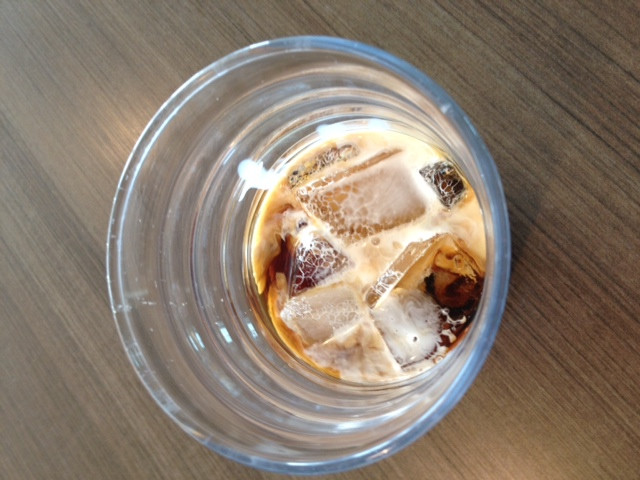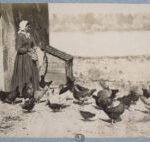Are you new to the world of cold brew coffee, or perhaps just coffee in general? Like many, my coffee journey started a bit later in life. Growing up, the rich aroma of coffee was always around thanks to my parents, but it wasn’t until a trip to Italy in 2008 that I truly understood the allure. Those early mornings in Italy, battling jet lag and late nights, were rescued by the delicious cappuccinos courtesy of our wonderful waiter, Lewlo. Since then, I’ve been hooked.
At work, my go-to is usually a Nespresso with a touch of raw sugar. Sometimes, when the weather calls for something cooler, I’d try to make iced coffee with our Keurig machine. The results? Often watery and just… not quite right. That’s when I stumbled upon the Pioneer Woman’s cold brew coffee recipe, and it all clicked. After trying it out a few times, I can confidently say it’s fantastic. Plus, I’ve even discovered a couple of personal touches that make it perfect for me.
 Cold brew coffee served with a splash of cold cream, highlighting its rich and creamy texture
Cold brew coffee served with a splash of cold cream, highlighting its rich and creamy texture
The real game-changer? For the price you’d spend on a single venti Starbucks iced latte, you can brew enough cold brew to last you 2-3 weeks! We’re talking about roughly $4 for the coffee grounds, a minimal cost for milk and sugar, and you’re set with delicious iced coffee for days.
You might also like: The Best Milk Frothers (& Steamers) for At-Home Use
The original Pioneer Woman recipe that inspired this is available here. And I must say, her food photography is simply stunning!
I’ve found an iced coffee recipe I love even more than cold brew—with the Aeropress!
The first time I experimented with this recipe, I used coffee beans I brought back from Puerto Rico (pictured above). More recently, I made a batch with Cafe Bustelo (the brick, not the can) from my local grocery store. The beauty of this recipe is its versatility – almost any coffee will do. However, for the richest and most robust flavor, I recommend using a strong, dark roast. I’m even considering trying it with hazelnut coffee soon for a flavored twist!
You might also like: A Gift Guide for the Coffee Lover in Your Life
To get started, you’ll need a large container (or possibly two, depending on the quantity you’re making). I had to get a bit creative myself – the container I used is truly the only thing I had on hand that was big enough! Pour all your coffee grounds into a large tub or giant mixing bowl. Then, add water – approximately half a gallon to a gallon for every pound of coffee grounds. I usually stick to a pound of coffee and half a gallon of water at a time, simply because my kitchen and fridge are quite small, and a larger batch can be overwhelming. However, rest assured, using a pound of coffee per gallon of water won’t result in watery coffee. (Updated Tip: I initially found that a pound of coffee with half a gallon of water was TOO strong! Stick with the pound/gallon or half pound/half gallon ratio for a balanced brew. Learned that from personal experience bouncing off the walls!)
Depending on your coffee consumption habits, this amount should easily last you a couple of weeks, or even longer.
It felt a bit like conducting a science experiment as I mixed everything together! Stir it thoroughly to ensure all the coffee grounds are fully saturated. The mixture will resemble mud pies or brownie batter – think delicious, caffeinated dirt.
Doesn’t that look fantastic? Seal the container tightly with plastic wrap (or a lid if you’re fortunate enough to have a container that large with a lid), and place it in the refrigerator for at least eight hours to steep. This steeping process is what truly makes it cold brew coffee. 🙂
Next, prepare your straining setup. You’ll need a vessel to strain the coffee into and a sieve or strainer that fits properly. I picked up a simple strainer at Target for around $5 and strained the coffee into a bowl. It’s a bit of an awkward setup with my current kitchenware, but it works!
Pioneer Woman recommends lining the strainer with a couple of layers of cheesecloth, which I’m sure works wonderfully. However, cheesecloth isn’t something I typically have on hand, so I’ve found that paper towels work just as effectively. I’ve also considered using coffee filters, although that might become a bit costly. In any case, line your strainer with something to prevent excessive coffee grounds from ending up in your final brew – unless you prefer a bit of sediment, of course!
Then, using a ladle or a similar tool, begin transferring the coffee mixture into the lined strainer. The filtering process will take some time, so patience is key. If you’re using paper towels, you’ll likely need to replace them a few times as they become saturated.
And there you have it! Cold-brew coffee concentrate, ready to fuel all your caffeine needs. Remember to refrigerate it and keep it sealed for optimal freshness.
A bit messy, perhaps, but totally worth it. Now, Pioneer Woman suggests simply stirring in sugar or using sweetened condensed milk as a sweetener. While I’m sure that sweetened condensed milk is incredibly delicious, it’s also packed with fat, sugar, and calories that I prefer to avoid. The first time I made a cup of iced coffee using this concentrate, I just added raw sugar, as I usually do. Big mistake! Why? Because sugar doesn’t dissolve well in cold liquids. And nobody enjoys crunchy coffee.
Yes, my only sealable pitcher is Winnie the Pooh themed – so what? To solve the undissolved sugar issue, I decided to make a quick simple syrup. I heated sugar and water on the stovetop – the exact amounts depend on your sweetness preference, so adjust to your taste. Bring it to a rolling boil, then reduce the heat slightly and let it simmer for a bit, stirring continuously to prevent burning. It should reduce and thicken slightly (though thickening isn’t my forte!). Let the simple syrup cool completely, and then you can either add it directly to your coffee concentrate (which is what I do) or store it separately and add it to each iced coffee as needed. I haven’t noticed any issues with adding it directly to the concentrate affecting its shelf life; mine has stayed perfectly fine for at least a week or two, and honestly, I usually finish it off pretty quickly anyway!
So, if you decide to give this Pioneer Woman Cold Brew Coffee recipe a try, please let me know how it turns out for you!


